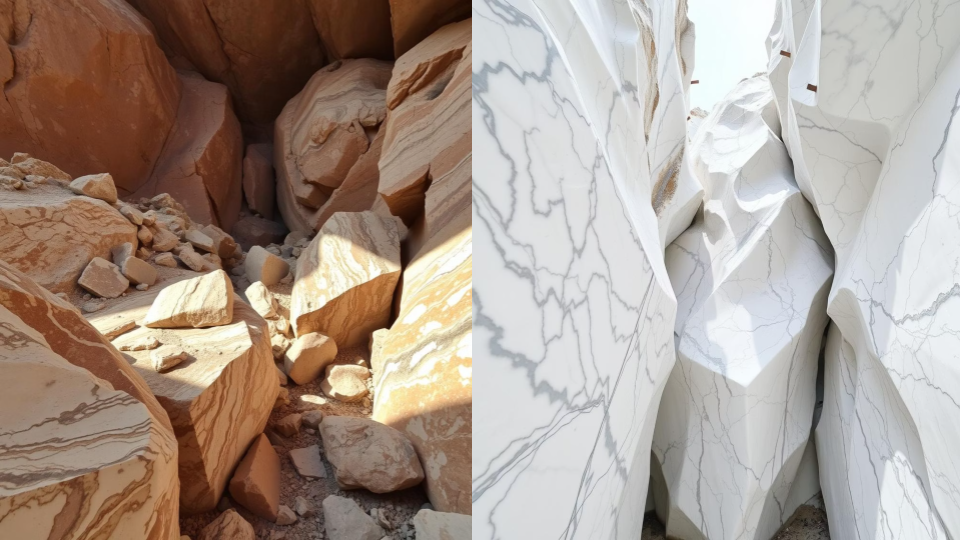When it comes to timeless elegance and natural luxury, marble remains a top choice for architects, interior designers, and homeowners alike. But one common question arises: Should you go for Indian marble or Italian marble?
Both options are undeniably beautiful and valuable, but they differ in terms of origin, appearance, performance, and cost. In this blog, we’ll walk you through a detailed comparison to help you make the right decision for your space.
1. Origin & Availability
Indian Marble: Quarried across various parts of India — especially Rajasthan (Makrana, Kishangarh, Udaipur), Gujarat, Andhra Pradesh, and Madhya Pradesh. Available in slabs, tiles, and blocks with custom thicknesses up to 30 mm.
- Italian Marble: Imported from the historic quarries of Northern Italy (Carrara, Tuscany, and Sicily). Typically available in pre-polished slabs of 18–20 mm thickness.
2. Appearance & Veining
- Italian Marble: Known for its high-gloss, “crystal-like” finish, smooth surface, and flowing, dramatic veins. Commonly found in shades of white, grey, and beige — a true hallmark of luxury.
- Indian Marble: Offers medium lustre and a rich spectrum of colors such as white, pink, green, yellow, and black. Its intricate, natural veining patterns offer distinct character to each slab.
3. Durability & Strength
- Indian Marble: Naturally denser and harder. Highly resistant to scratching and chipping — ideal for heavy footfall zones like kitchens and corridors.
- Italian Marble: Though visually stunning, it is softer and more porous. Often reinforced with epoxy resins and nylon backing to improve its strength and prevent cracking.
4. Maintenance & Care
- Italian Marble: Requires regular sealing, gentle cleaning products, and immediate care to avoid etching or stains. Not ideal for high-use kitchens or bathrooms.
- Indian Marble: Easier to maintain, with fewer sealing requirements. Handles rougher usage and cleaning agents better, making it suitable for family homes.
5. Thickness & Installation
- Indian Marble: Comes in variable thickness (up to 30 mm) and is easier to install. Local masons are well-versed with its handling.
- Italian Marble: Supplied in standard 18–20 mm slabs and needs skilled craftsmanship for cutting and installation. Improper handling can lead to cracks.
6. Cost Comparison
- Indian Marble: Very cost-effective, with prices ranging from ₹80–₹150/sq. Ft, depending on variety and polish.
- Italian Marble: Considered a premium product. Prices start around ₹350/sq. Ft and can go up to ₹900+, factoring in import duties and installation.
7. Best Applications
| Area | Indian Marble | Italian Marble |
|---|---|---|
| Flooring | Perfect for all home interiors | Ideal for luxury foyers & living areas |
| Kitchen Countertops | Durable and easy to maintain | Not recommended (porous & delicate) |
| Bathrooms & Walls | Practical & moisture-resistant | Excellent for decorative bathroom walls |
| Tabletops & Accents | Budget-friendly & functional | High-end look for statement furniture |
8. Environmental Impact
- Indian Marble: Locally sourced, so it has a lower carbon footprint. Usually processed without chemical reinforcement.
- Italian Marble: Imported and often treated with epoxy resins or nylon netting, contributing to a higher environmental impact.
9. Notable Varieties 🇮🇳 Popular Indian Marbles:
- Makrana White – Historical marble used in the Taj Mahal. High purity and strength.
- Udaipur Green – Earthy green tone with linear veining.
- Jodhpur Pink – Soft, elegant pink ideal for interiors.
- Ambaji White – Snowy white with subtle patterns.
- Indian Onyx – Translucent and unique, often used for backlit panels.
10. 🇮🇹 Popular Italian Marbles:
- Carrara – Classic soft white with grey veins.
- Calacatta – Striking bold veins on a brilliant white base.
- Statuario – Rare and premium; perfect for feature walls.
- Botticino – Creamy beige tones with uniform texture.
- Nero Marquina – Elegant black marble with bright white streaks.
At a Glance: Summary Table
| Feature | Indian Marble | Italian Marble |
|---|---|---|
| Lustre | Medium | High, crystal-like |
| Hardness | Hard, dense | Softer, needs reinforcement |
| Thickness | Up to 30 mm | Standard 18–20 mm |
| Maintenance | Low–medium | High (needs sealing/polishing) |
| Cost | ₹80–150/sq. ft | ₹350–900+/sq. ft |
| Best Use | Kitchens, flooring | Foyers, accent walls, décor |
| Sustainability | Local, low impact | Imported, higher impact |
Final Verdict: Which One Should You Choose?
- Choose Indian marble if you’re looking for durability, affordability, and practicality. It’s perfect for everyday flooring, kitchen counters, and high-use zones.
- Opt for Italian marble if you want a luxurious, statement-making aesthetic. Ideal for showstopper designs in living rooms, bathrooms, and luxury commercial spaces — but be ready for added maintenance and costs.
Final Takeaway
Both Indian and Italian marbles are timeless and beautiful. Your choice depends on your design goals, budget, and the intended use of the space.





